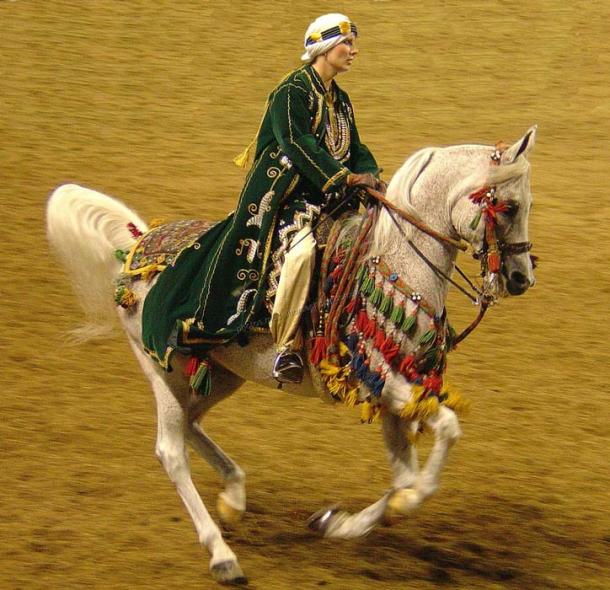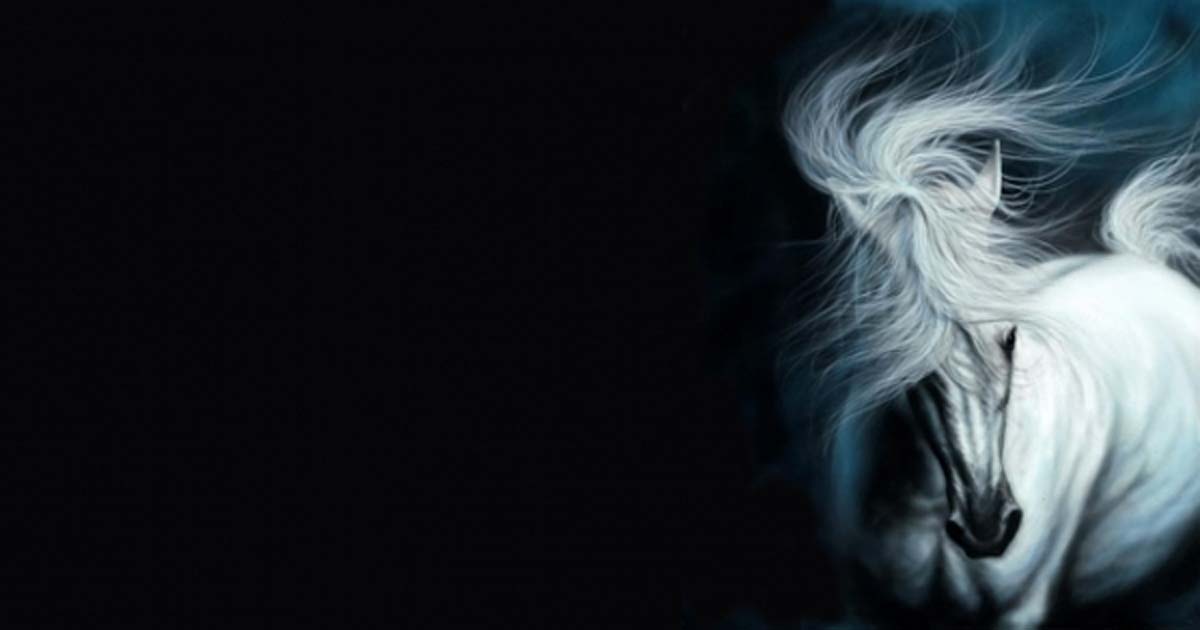Horses of Antiquity, Their Ancient and Sacred History
In the myths of the horse we see the ancient and sacred history of humanity. Throughout this history is etched the passage of man as warrior, priest, healer, builder of dreams, wrecker of worlds. Some mystics say that we can see all of this in the eye of the horse -- in the prism of the pupil is written the beginning, and perhaps, the end of it all.
In the very image or shadow of the horse is the cosmos of collective human memory; our folly, fantasy, failure and ingenuity.
It is all written in the oral literature of the equine. You might ask, "Were not dogs and cats there on the human scene earlier having even more impact upon our myths?" The roughly 5,000 year cycle of stories that revolves around all three animal archetypes raises and answers this question.
Canine mythology explains that God, seeing Man so feeble, gave him Dog, so he wouldn't be lonely.
Feline mythology suggests that we could not see God -- but we could see, and worship, Cat wherein God dwelt.
Equine mythology takes a different position. It states and impossible but not unimaginable beauty: Man, the ancient parables say, was once Horse. And that is only the beginning of the story.
Let's imagine then that the cat and the dog got us safely down the path of life. But the horse got us into the gloried and storied magic wood of the world. And in riding on horseback we discovered that the thing we were searching for was right there, under us -- Horse!
The mythology of the horse is also a wild ride on the mare of night. Nightmare. Through which, by turns, by leaps and gallops, we find that the mount is seldom ennobled by the rider; it is almost always the other way around, whether it is Don Quixote or Jeanne d'Arc, the human in us rises to a greater sense of self when on horseback.

Jeanne d’Arc (Joan of Arc) on her horse. (public domain)
We are without doubt bettered and brightened by virtue of the horse's dignity and equanimity. In this regard, think for a moment of Comanche, the sole survivor of the 7th Cavalry -- the singular historical horse that survived the 19th century Battle of the Little Big Horn. After the last bullet was fired, Comanche was seen standing faithfully beside his fallen man.

Comanche’s final resting place: On display at the University of Kansas. Credit: University of Kansas
This archetypal image painted on canvas thousands of times celebrates an event that should not have happened. As it says in the Koran: "By the snorting war steeds, which strike fire with their hoofs as they gallop to the raid at dawn and with a trail of dust split apart a massed army; man is ungrateful to his Lord! This he himself shall bear witness."
The Chargers 100: 1-7
Yet, historically, it was through breeding and racing, that human culture rose to the level of greatness. The human lineage goes from Adam to Ishmael, from Ishmael to Solomon, and from Solomon to Muhammad. Even before Abraham there was Baz, the great-great grandson of Noah. The famed mare, Baz, was named after the man of that name and bred to the stallion, Hashaba.
Bedu horse breeders lived by an unwritten code of honor. If a travel merely touched a Bedu tent pole, he became a welcome guest whose horse's bridle was hung from the highest point of the tent to show the greatest respect towards the visitor.
It has been said that the Arabian horse became a healer of nations. The mother of blooded foals united all. Stallion, mare and foal; man, woman, child. And the races of horses on the desert plain, far from dividing people, brought them together. It was a tradition that the winners of celebrated races got the finest stock from the loser's herd. This diversity made champion racers, horses of myth. As an unknown Arab poet wrote long ago --
The nostrils of a racer are like the petals of a rose.
The neck is an elongated wave from which floats
brilliant ripples of silken mane.
The ears, inward pointing, are lilies in trembling water
and the entire body of the horse sways with the strength
of wind, sun and sand.

An Arabian horse in "native" costume, used in both exhibition and competition (public domain)
Interestingly, King Solomon disregarded the Israelite law that forbade the keeping of horses. Instead he built stables for 40,000 horses of Arabian blood. Some of these were taken by King Solomon's son Menyelek (whose mother was Makeda, the Queen of Sheba) who bore the sacred Ark of the Covenant from Judah to Ethiopia.
Menyelek's caravan traveled as if upon the wind, as The Kebra Nagast (The Glory of the Kings), which is the African version of the Bible, tells us they were watched over by angels. In Egypt the soldiers of King Solomon, who were in rapid pursuit of the stolen Ark, questioned the people there. "...And the Egyptians said to them, 'Some days ago the travelers you seek came by here in wagons which moved swifter than the eagles of the heavens.'"

The Queen of Sheba on horseback enters Jerusalem, Ethiopian fresco (public domain)
Mythology has woven a tangled web about the feet of King Solomon, a snare from which he couldn't extract himself. He loved horses and wanted a great stallion, but he had to break Moses' decree not to "multiply horses unto himself." We know from history that Solomon married Pharaoh's daughter -- she a worshiper of idols in the form of golden insects and horses, too.
Sunlight and horses are symbolic in Arab literature, the horse of the sun being one of the oldest metaphors on earth. Curiously, it is the Sun Horse of the American Indian that may have galloped across the centuries and continents to arrive upon American soil:
I am the Sun's son
I sit upon a turquoise horse at the opening of the sky
My horse walks upon terrifying hooves and stands
on the upper circle of the rainbow with a sunbeam in his mouth
for a bridle
My horse circles all the peoples of the earth
Today I ride on his broad back and he is mine
Tomorrow he will belong to another
This poem, or chant, is translated from the Navajo, but who can say from whence it sprang? Maybe Mongolia and before that Sumeria. But possibly it came from the heart of Mother Earth or Changing Woman. However, its intent is that equine love is universal.
In harmony it is done
In harmony it is finished
May harmony be all around me
All the days of my life

The horse of the sun is one of the oldest metaphors on earth (public domain)
This Navajo celebration of balance is also universal. Native people of North America have stated that the gift of balance was bestowed upon them by the horse who is sometimes called "mysterious dog". This incorporates two sacred animals into one. To the Dakota the horse was sunkawakan, mystery dog but the Shawnee called the horse mishawa.
or elk.
When the conquistadores visited the Hopi in 1583 tribal people spread cotton scarves on the ground for the horses to walk upon.
So, taken all in all, if God gave Dog to Man to keep him from being lonely ... and Cat to help him see God, then Horse must be the gift that united all four of them, thus giving Man, as the Navajos sometimes say, "holy mobility," the grace to come and go as one pleases.
“Gerald & Loretta Hausman have authored many books about animals in mythology including The Mythology of Horses: Horse Legend and Lore Throughout the Ages.”
Top image: White Horse by Tom274 / DeviantArt



















